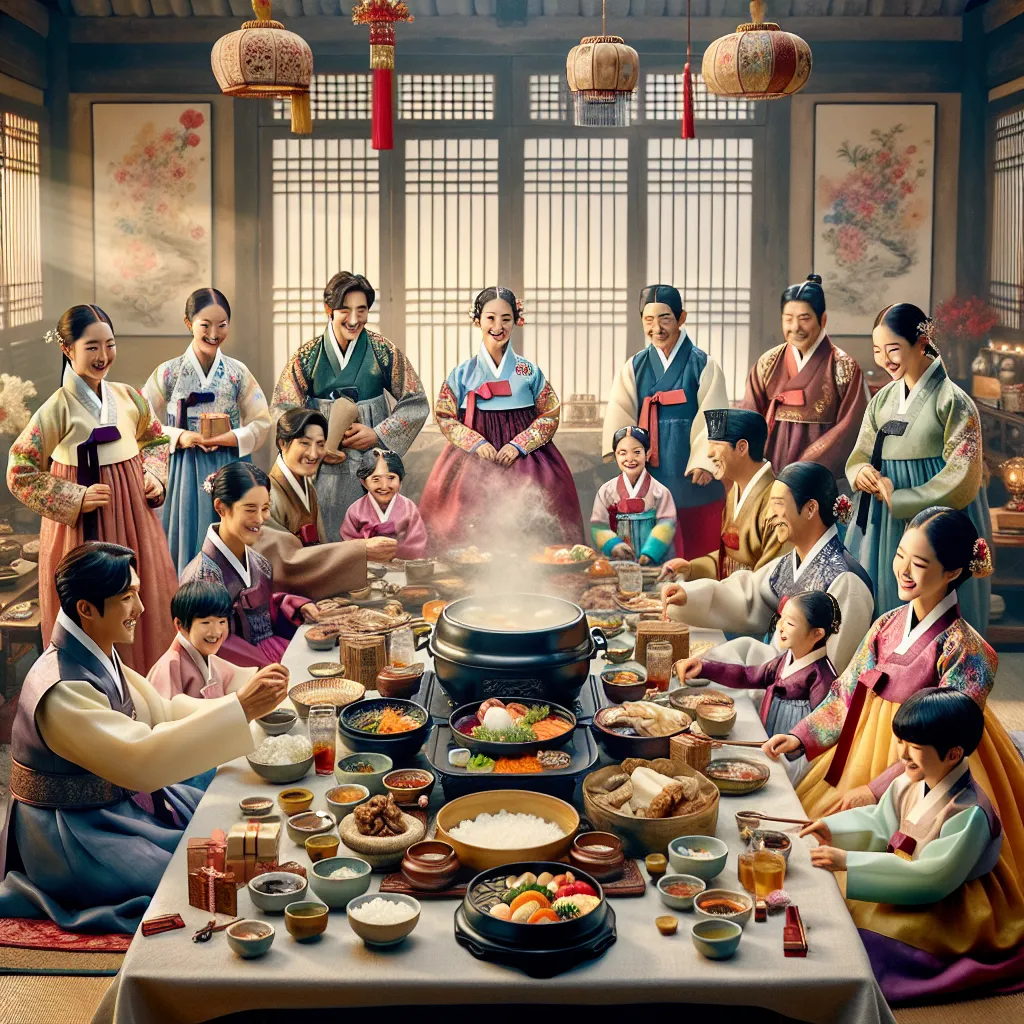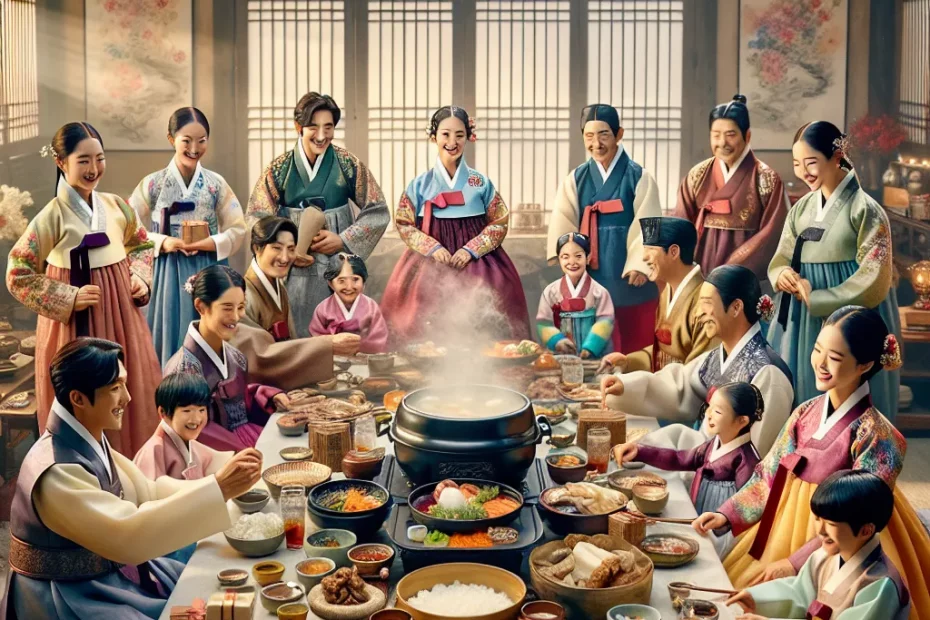As we delve into the rich tapestry of Korean culture, one cannot overlook the vibrant tapestry of traditions and customs that define the celebration of Seollal, the Korean Lunar New Year. This auspicious occasion holds deep cultural significance, embodying values of family, respect, and renewal. From the elaborate rituals to the mouth-watering delicacies, Seollal offers a glimpse into the soul of Korea. Join me on a journey through the essence of Seollal, exploring its meaning, traditional foods, customs, and the evolving modern celebrations that shape this cherished holiday. Embrace the spirit of Seollal as we unravel the layers of this time-honored tradition, shedding light on the beauty and depth of Korean Lunar New Year festivities.

The Meaning of Seollal in Korean Culture
Seollal, also known as Korean Lunar New Year, holds significant cultural and traditional importance in Korea. This annual holiday marks the beginning of the lunar calendar and is a time for families to come together, pay respects to ancestors, and celebrate with various customs and rituals. 🌙🎉
Ancestral Memorial Rites – “Charye”
One of the key traditions during Seollal is the ancestral memorial rites, known as “charye.” Families gather to pay tribute to their ancestors by offering food and drinks on an altar, bowing as a sign of respect. This ritual symbolizes the importance of honoring and remembering one’s roots and heritage. 🙏🍚
Traditional Food – Tteokguk
Another essential aspect of Seollal is the traditional food enjoyed during this festive time. Tteokguk, a savory rice cake soup, is a staple dish served during the holiday. Eating tteokguk is believed to bring good luck and symbolizes growing one year older. The sound of slurping the long rice cakes is said to bring prosperity and longevity. 🍲🥢
Customs and Activities
In addition to ancestral rites and traditional foods, Seollal is a time for various customs and activities. One popular game played during the holiday is Yutnori, a traditional board game involving sticks and a wooden board. Families gather around to play this game, fostering camaraderie and friendly competition. 🎲👨👩👧👦
Seollal is not just a time for celebration but also a period for reflection and gratitude. It serves as a reminder to cherish family bonds, express gratitude for the past year, and set intentions for the year ahead. The values of respect, unity, and tradition are deeply embedded in the fabric of Seollal, making it a cherished and revered holiday in Korean culture. 🌟🎎
As Koreans around the world come together to celebrate Seollal, the essence of this holiday continues to thrive, carrying on centuries-old traditions and customs that enrich the cultural heritage of Korea. Seollal embodies the spirit of unity, gratitude, and renewal, making it a time-honored and cherished festival that resonates with the hearts of Koreans everywhere. 🌸🌠
In conclusion, Seollal holds profound significance in Korean culture, serving as a time to honor ancestors, celebrate traditions, and strengthen family bonds. This auspicious holiday encapsulates the essence of Korean identity and heritage, embodying values of respect, unity, and gratitude that are passed down through generations. May the spirit of Seollal continue to shine brightly, illuminating the path for a prosperous and harmonious year ahead. 🌺🌕
Traditional Seollal Food and Recipes
As we delve into the rich tapestry of Korean culture, one cannot overlook the significance of Seollal, the Korean Lunar New Year. This auspicious occasion is steeped in tradition, with various customs and rituals that have been passed down through generations. One of the central elements of Seollal celebrations is the array of traditional foods that are prepared and enjoyed during this time. Let’s explore some of the most iconic Seollal foods and the recipes that have been cherished by Korean families for centuries!
Tteokguk (Rice Cake Soup)
Tteokguk holds a special place in the hearts of Koreans during Seollal. This hearty soup is made with sliced rice cakes, beef broth, and garnished with egg, seaweed, and other toppings. The round shape of the rice cakes symbolizes good luck and prosperity for the coming year. It is believed that by eating Tteokguk, one gains a year in age, marking the passage of time and the start of a new beginning.
Jeon (Korean Pancakes)
Jeon, a variety of savory pancakes, is a staple dish during Seollal festivities. These crispy delights are made by coating various ingredients such as vegetables, seafood, and meat in flour and egg batter, then pan-frying them to golden perfection. Jeon symbolizes wealth and prosperity, as the golden color represents good fortune and abundance in the new year.
Yakgwa (Honey Cookies)
Yakgwa, or honey cookies, are a sweet treat enjoyed during Seollal. These deep-fried cookies are made with flour, honey, sesame oil, and ginger, creating a unique blend of flavors that tantalize the taste buds. Yakgwa is shaped into intricate designs, symbolizing longevity and happiness. The sweetness of these cookies represents the hope for a sweet and harmonious year ahead.
Sikhye (Sweet Rice Drink)
Sikhye is a traditional Korean beverage made from malted barley, rice, and sugar. This sweet and refreshing drink is a popular choice during Seollal, as it is believed to bring good luck and prosperity. Sikhye is often served cold, making it a delightful refreshment to enjoy with the sumptuous Seollal feast.
In conclusion, Seollal is a time of joy, reflection, and celebration for Koreans around the world. The traditional foods and recipes shared during this auspicious occasion not only satisfy the palate but also carry deep symbolic meanings of luck, prosperity, and happiness for the new year. Let us embrace the spirit of Seollal and savor these delectable dishes that connect us to our cultural heritage and traditions. Happy Seollal to all!
Customs and Rituals During Seollal Celebrations
As the Korean Lunar New Year, Seollal, approaches, families across South Korea and around the world prepare to partake in a variety of customs and rituals to usher in the new year with prosperity and good fortune. This traditional holiday, which typically falls between late January and mid-February, holds great significance in Korean culture, emphasizing the importance of family, respect for ancestors, and the hope for a successful year ahead. Let’s delve into some of the fascinating customs and rituals observed during Seollal celebrations!
🎊 Charye – Ancestral Rite
One of the central rituals of Seollal is the Charye, an ancestral rite where families pay their respects to deceased ancestors. A table is meticulously set with various offerings such as rice cakes, fruits, and traditional dishes. Through deep bows and offerings, families express gratitude and seek blessings for the upcoming year from their ancestors. This solemn ceremony underscores the deep-rooted respect for familial lineage and heritage in Korean society.
🏮 Sebae – New Year’s Bow
During Seollal, a significant custom known as Sebae takes place, where younger family members perform deep bows to their elders as a sign of respect. In return, elders offer blessings and words of wisdom for the new year. This gesture symbolizes the passing down of traditions, values, and good wishes from one generation to the next, fostering harmony and unity within the family.
🎎 Yutnori – Traditional Games
Seollal festivities are incomplete without the lively and competitive game of Yutnori. This traditional board game, played with four wooden sticks, involves strategic moves and teamwork. Families gather around to engage in friendly competition, laughter, and bonding. Yutnori is not just a game but a reflection of the collective spirit and camaraderie that defines the essence of Seollal celebrations.
🎐 Sagunja – Fortune Telling
As the new year dawns, many Koreans turn to the age-old practice of Sagunja, or fortune telling, to gain insights into what the future holds. From interpreting dreams to consulting shamans or fortune tellers, Sagunja plays a significant role in guiding individuals towards making informed decisions and navigating the uncertainties of the coming year. It adds an element of mystique and anticipation to the Seollal festivities.
In conclusion, Seollal is a time-honored tradition that encapsulates the rich cultural heritage and values of the Korean people. Through customs like Charye, Sebae, Yutnori, and Sagunja, Seollal celebrations not only foster familial bonds but also instill a sense of continuity, respect, and hope for the future. As families come together to observe these rituals, they not only honor their past but also look forward to a year filled with blessings, prosperity, and togetherness. Happy Seollal to all! 🌟🎆
Modern Celebrations and Changes in Seollal Traditions
As we delve into the vibrant tapestry of Seollal, the Korean Lunar New Year, it becomes evident that this cherished holiday is not just a time of celebration, but also a reflection of the rich cultural heritage of Korea. In recent years, modern celebrations of Seollal have evolved, blending traditional customs with contemporary practices to create a unique and dynamic festive experience.
Changes in Seollal Traditions
One significant change in Seollal traditions is the way families reunite and celebrate. In the past, Seollal was a time when families gathered in their ancestral homes to pay respects to their ancestors and share a feast together. However, with the rapid urbanization and modernization of Korean society, many families now opt for more convenient ways to celebrate Seollal. This has led to an increase in travel during the holiday season, with many people choosing to visit popular tourist destinations or take trips abroad.
Despite these changes, the essence of Seollal remains deeply rooted in tradition. One of the most iconic customs of Seollal is the ancestral ritual known as Charye. During this solemn ceremony, families offer food and drink to their ancestors as a sign of respect and gratitude. This ritual is believed to bring blessings and good fortune to the family for the coming year.
Another traditional practice that continues to be an integral part of Seollal is the Sebae ceremony. This ritual involves younger family members bowing to their elders and presenting them with a deep bow and a heartfelt New Year’s greeting. In return, the elders give blessings and words of wisdom to the younger generation. This ritual symbolizes the importance of filial piety and respect for one’s elders in Korean culture.
In addition to these timeless customs, modern celebrations of Seollal also incorporate fun and festive activities for all ages. From playing traditional games like Yutnori to enjoying delicious holiday dishes such as Tteokguk (rice cake soup), Seollal offers a plethora of experiences that cater to both the young and the young at heart.
As we embrace the changes in Seollal traditions and celebrate the holiday in new and innovative ways, it is important to remember the cultural significance and historical roots of this auspicious occasion. By honoring the past while embracing the present, we ensure that the spirit of Seollal continues to thrive and inspire future generations to cherish and celebrate their heritage.
In conclusion, Seollal remains a time of joy, reflection, and togetherness, where old traditions blend harmoniously with modern celebrations to create a truly memorable experience for all. Let us embrace the spirit of Seollal with open hearts and minds, celebrating the past, present, and future in unity and harmony. Happy Seollal to all! 🎉🏮🎊
As we delve into the rich tapestry of Seollal traditions and customs, it becomes evident that this Korean Lunar New Year celebration is not just a mere festivity, but a profound reflection of the country’s cultural heritage. From the symbolic significance of ancestral rites to the mouth-watering array of traditional foods, every aspect of Seollal encapsulates centuries-old customs passed down through generations. The meticulous rituals performed during this time serve as a poignant reminder of the importance of family, respect for elders, and the spirit of unity. Moreover, as modernity intertwines with tradition, witnessing the evolving nature of Seollal celebrations highlights the dynamic nature of Korean society. Embracing change while cherishing the roots is a testament to the resilience and adaptability of Korean culture. In essence, Seollal is not just a festival; it is a living, breathing testament to the enduring values and customs that define Korean identity.
